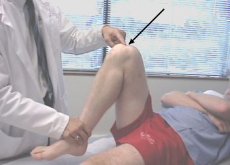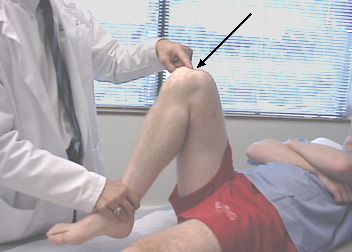Medical expert of the article
New publications
Knee pain when bending the knee
Last reviewed: 06.07.2025

All iLive content is medically reviewed or fact checked to ensure as much factual accuracy as possible.
We have strict sourcing guidelines and only link to reputable media sites, academic research institutions and, whenever possible, medically peer reviewed studies. Note that the numbers in parentheses ([1], [2], etc.) are clickable links to these studies.
If you feel that any of our content is inaccurate, out-of-date, or otherwise questionable, please select it and press Ctrl + Enter.

Knee pain when bending is the most common reason why people visit traumatologists. The knee is the largest weight-bearing joint in the body, which is subject to significant stress when a person walks, runs, or actively plays sports. The knee often bends, straightens, and straightens, and this causes even more pain. The knee joint can also slide and rotate. Pain when bending the knee is a sign of injury or damage to the joint. We will list the main diseases that can cause knee pain when bending.

Diseases that cause knee pain when bending
Arthritis
Several types of arthritis can affect knee health. Doctors at the Mayo Clinic say osteoarthritis is the most common type of arthritis that affects large joints like the knee. Other types that can potentially affect the knee include septic arthritis, rheumatoid arthritis, and gout, as well as a form of common arthritis. People with arthritis experience varying degrees of pain when standing and walking, swelling, stiffness, and loss of flexibility, including difficulty and pain when bending the knee.
Patellar tendinitis
Tendinitis is irritation or inflammation of one or more tendons that support the joints of the knee. It is often the result of overtraining or too much activity when walking or running. According to the Mayo Clinic, athletes are more likely to develop patellar tendinitis than people who are moderately active. The tendon connects the quadriceps muscle at the front of the thigh to the shin bone. Runners, skiers, and cyclists are at higher risk for pain from tendinitis because their ligaments and joints are under constant strain. They may experience pain with normal bending, even without putting much stress on the knee.
Patellofemoral pain syndrome
People with this syndrome may feel pain under or around the kneecap. The pain gets worse when bending or after sitting for a long period of time. The American Academy of Family Physicians recommends that people who have this dangerous injury try to rest from their activities. Doctors also recommend that they put ice on the knee several times a day and change the type of shoes they use to more comfortable ones. Exercises also help strengthen the muscles around the kneecap and relieve knee pain.
Bursitis
This is an inflammation of the small sac of fluid that cushions the edges of the knee joint. According to the Mayo Clinic, bursitis causes significant knee pain when bending, especially if the knee is subject to increased stress. For example, when walking up or down stairs. People with bursitis may also experience symptoms such as redness, swelling, warmth, or heat.
Osgood-Schlatter disease
Osgood-Schlatter disease is an inflammation of the bones, cartilage, and tendons in the upper leg. The condition often affects only one knee, according to pediatric surgeons, typically in teenagers, who are more prone to injury because they are more physically active. Osgood-Schlatter disease usually worsens during growth spurts and is most common in teens who play sports that involve twisting, running, or jumping. Knee pain can range from mild to severe and constant. It gets worse with exercise and bending.
Baker's cyst
Baker's cyst is a disease that is an accumulation of fluid that forms under the knee. It can be caused by a hernia of the knee joint, a ruptured capsule or a ruptured meniscus, damage to the cartilage of the knee joint. The thrombus that forms in this case can be immediately dangerous and requires immediate medical attention.
Who should you contact if you experience knee pain when bending?
If you have knee pain when bending, you should see a doctor as soon as possible. Diagnostics is usually not difficult, but it is necessary to determine the correct picture of the disease and make an accurate treatment plan. Diagnostic methods may include palpation, X-ray, arthroscopy of the knee joint or diagnostic puncture.


 [
[